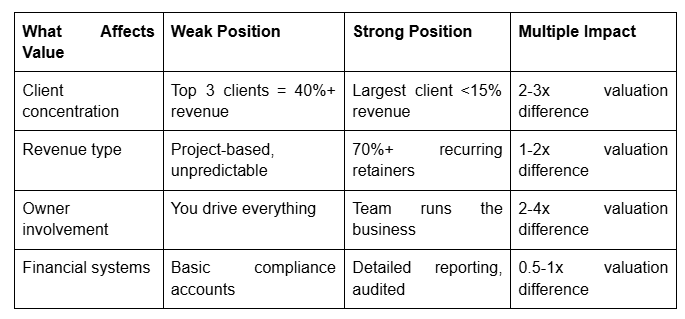M&A Readiness: Building an Acquisition-Ready Agency

Ask any agency owner about their exit plans, and you'll hear "in five years" or "when the time's right." Ask what they're doing today to prepare, and you'll hear crickets.
Well, the work that determines whether you'll achieve a premium valuation or accept a disappointing offer happens years before you even think about calling a corporate finance adviser. The agencies selling for 7-8x EBITDA spent years systematically building the characteristics buyers actually pay for.
Whether you're planning to sell in three years or just want to build a more valuable business, the preparation work is identical. Better financials, stronger client relationships, documented processes, and reduced owner dependency make your agency both more valuable and easier to run today.
What Buyers See When They Look at Your Agency
Forget everything you think makes your agency valuable. Buyers aren't impressed by your creative awards, your fancy office, or how hard you work. They're buying one thing: predictable future cash flows with manageable risk.
Every question they ask, every document they review, every conversation with your team traces back to a single concern—can they depend on these profits continuing after they write the cheque?
Here's how the maths works:

Stack weak positions across all these factors, and you're looking at 3-4x EBITDA. Stack strong positions, and you're commanding 7-8x. Same revenue, same profit, completely different cheque.
Why Most Agencies Leave Money on the Table
The typical agency sells for less than it could have because the owner spent years building a successful business but never thought about building a sellable one. The difference matters more than you'd think.
You've built your largest client to 40% of revenue because they kept giving you more work and you kept saying yes. Buyers see a business that collapses if one relationship sours. They'll discount your valuation by 30-40% for that single risk factor.
Your team knows you run the show. Client relationships live in your head, strategy happens in your conversations, and major decisions wait for your input. Buyers see a business they're buying plus a job they're creating for themselves. They'll pay accordingly.
Your finances show profit, but not much else. Basic accounts prepared for tax compliance don't tell buyers anything about client profitability, service line performance, or business drivers. Without detailed financials, buyers assume problems you're hiding and reduce their offers to compensate for uncertainty.
Build A Strong Financial Foundation
Start here, because everything else builds on solid financial infrastructure. If you want a detailed walkthrough of how to increase both your EBITDA and your multiple to maximise exit value, I've covered the complete framework in this video.

Get Your Accounts Audited
Most agencies run on unaudited accounts. That works fine until you're trying to sell and buyers are questioning every number on your P&L.
Audited accounts expect £10,000-25,000 annually depending on size and complexity. But they achieve three things that matter enormously during acquisition:
- They prove your profit is real. Buyers trust audited numbers. They question everything else.
- They force you to fix messy accounting practices before buyers discover them. That client refund you coded as a marketing expense? The personal costs running through the business? The inconsistent revenue recognition? Auditors find it all and make you fix it.
- They create a three-year track record of clean financials. One year of audited accounts before sale looks suspicious. Three years shows a business that's been professionally managed.
Start audits 2-3 years before you think you'll sell. Earlier if your accounts are particularly messy.
Show What You're Really Earning
Your reported profit probably understates what a buyer will actually make from your business. Normalisation adjustments bridge this gap by removing owner-specific costs and one-time expenses that won't continue under new ownership.
Common adjustments include:
- Your above-market salary and benefits
- That car the business pays for
- One-time legal costs or office relocations
- Related party transactions at non-commercial rates
- Discretionary spending that won't continue
The difference between reported and normalised EBITDA often hits 20-40% for owner-managed agencies. But every adjustment needs bulletproof documentation. Buyers will challenge anything that smells like creative accounting.
Prepare detailed schedules for each adjustment, gather supporting evidence, benchmark your compensation against market rates for hired CEOs doing similar roles, and be ready to defend every number.
Build Reporting Systems That Impress
Monthly management accounts within two weeks of month-end. Client profitability analysis. Pipeline reporting with conversion metrics. Cash flow forecasting. These are proof you actually understand and control your business.
Buyers reviewing these systems form immediate impressions about management sophistication.
Strong systems signal professional management, deep business understanding, and low acquisition risk. This supports premium valuations and smooth due diligence.
Weak systems signal potential problems hiding in poor data, management that flies blind, and high integration risk post-acquisition. This triggers valuation discounts and intense due diligence scrutiny.
You can't build these systems in the six months before approaching buyers. The data history, process maturity, and team capability required take years to develop properly.
Client Portfolio: Your Biggest Value Driver
Nothing impacts valuation more dramatically than client portfolio composition. Fix this early, because you can't solve concentration problems quickly without risking the relationships that created them.
The Concentration Problem
Consider this: 45% of revenue from one client. Sounds brilliant when they're growing and paying on time. Sounds terrifying when you're trying to sell.
Buyers will absolutely hammer your valuation for concentration. They're pricing in the real risk that your business implodes if that client leaves six months after they acquire you.
Fixing concentration requires years.
- Year one: Target new business development in complementary segments. Accept that growth elsewhere initially increases total revenue without reducing the dominant client's percentage immediately.
- Year two: Continue building other relationships whilst managing the major client carefully. You're aiming for gradual percentage reduction as other revenue grows.
- Year three: Achieve a more balanced portfolio through sustained new business success and organic growth across multiple clients.
Attempting to fix 40%+ concentration in six months before sale typically means either losing the major client (destroying value) or failing to fix the problem (accepting a valuation discount).
Revenue Quality Matters
Not all revenue is equal. Buyers will pay 1.5-2x more for agencies with recurring revenue models versus those dependent on project sales.
Long-term retainers with automatic renewal and strong retention rates create predictable revenue that buyers trust. Document retention rates by client segment, renewal rates and reasons for losses, and pricing power demonstrated through regular rate increases.
Contracted revenue with defined terms provides visibility into future performance. Track contracted revenue by quarter for next 12 months, pipeline of renewals and expansion opportunities, and average contract value and contract lengths.
Project revenue requires constant reselling and creates uncertainty buyers price into their offers. Even if total revenue and profit match retainer-based competitors, you'll achieve lower multiples purely due to revenue model.
Getting Yourself Out of the Business
You are probably the biggest obstacle to a premium valuation. Not because you're bad at running your agency but because buyers need a business that works without you.
Why This Is Hard
You've spent years building client relationships personally. You're the one clients want on calls. You make the strategic decisions. You're often the lead on new business. Systematically removing yourself from all these activities without damaging the business takes time and careful planning.
Start with client relationships. Identify your ten largest clients and map out 18-24 month transition plans for each.
Introduce senior team members as co-leads on accounts. Your involvement continues but starts shifting toward oversight rather than execution. Then, transition day-to-day client contact to team members. You're still involved in strategic conversations but not weekly operations. Also, step back from strategic involvement on most clients. You're available if needed but not driving relationships. Then, learn to see that client relationships are fully owned by the team. You're essentially unnecessary to ongoing relationship health.
Rush this process, and clients get nervous. Take it systematically over two years, and most won't even notice the transition happened.
Building Management Depth
Buyers want to see a management team capable of running the business without the founder. This means hiring, developing, and genuinely empowering senior leaders who can operate autonomously.
Look for gaps in your current structure. Do you have a strong operations director who actually runs delivery? A commercial director who drives new business? A finance director who manages the numbers? If you're filling any of these roles yourself, you've got work to do.
Plan 12-18 months for each senior hire to properly embed and demonstrate capability. They need time to build relationships, understand the business deeply, and prove they can operate without your constant involvement.
Process Documentation: Boring But Valuable
Buyers love documented processes. They represent intellectual property, reduce key person risk, and enable consistent delivery under new ownership.
You don't need to document everything! That's a recipe for creating binders nobody reads. Focus on the processes that actually matter:
Service delivery methodologies that produce your results. How do you approach strategy development? What's your creative process? How do you manage client engagements from kickoff to completion?
Client onboarding systems that ensure consistent experience regardless of which team member handles it. From initial kickoff through regular reporting, documented processes create scalability.
Business development approaches that work for your agency. What's your qualification process? How do you scope and price new work? What proposal formats and pricing models do you use?
Start with your highest-revenue service and document that thoroughly. Then move to the next. Trying to document everything simultaneously typically means documenting nothing well.
When to Bring in the Professionals
Corporate finance advisers, M&A lawyers, and specialist accountants all play crucial roles in acquisition processes. Timing their involvement matters.
- Corporate finance advisers should engage 12-18 months before anticipated sale. They'll provide valuation perspectives, identify preparation gaps, suggest positioning improvements, and ultimately manage buyer processes when you're ready.
- M&A lawyers become critical during active processes but can help earlier by reviewing commercial contracts for problematic provisions, addressing employment documentation gaps, and conducting compliance audits before buyers discover issues.
- Specialist tax advisers help structure the transaction for optimal tax outcomes. Entrepreneurs' Relief (now Business Asset Disposal Relief), share versus asset sales, earnout structuring, and other considerations can create tax differences of hundreds of thousands on the same deal.
Don't skimp on advisers to save fees. Professional support typically pays for itself many times over through better outcomes.
Start Building Value Today
The beautiful thing about acquisition readiness? Every improvement that makes your agency more sellable also makes it more profitable, easier to manage, and more resilient to challenges.
Building better financial systems helps you make smarter decisions today. Reducing client concentration decreases risk in your current business. Developing your management team creates capacity for you to focus on strategy. Documenting processes enables consistent delivery at scale.
Whether you sell in three years, ten years, or never, the work creates value you'll capture regardless of exit timing.
Ready to start building towards an eventual exit?
Our team specialises in the financial preparation that supports premium agency valuations. We can help you implement robust reporting systems, prepare for audits, and create the financial infrastructure buyers expect from professionally managed businesses.
Let’s discuss your exit aspirations and build a preparation roadmap. Book a call today!




